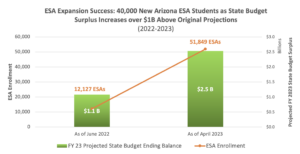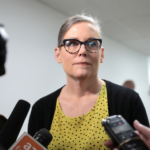Arizona ESAs Surge as State Budget Surplus Swells by $750 Million
Arizona’s bet on universal school choice is already paying off. At the same time that enrollment in the state’s Empowerment Scholarship Account (ESA) program is surging, the state’s revenue surplus has gone through the roof.
In the first four months of 2023 alone, enrollment in Arizona’s ESA program has soared by 7,000 students, bringing the total number of children served to over 51,000. And now, new data released this past week by the nonpartisan Joint Legislative Budget Committee (JLBC) show that over a similar period, the state’s estimated revenue surplus has surged by an extra $750 million, putting the total state budget surplus this year at $2.5 billion.
Before Arizona’s historic universal ESA expansion took effect, just 12,000 students were participating in the program. This means that during the first school year where every family in the state can use their child’s public education dollars to customize that student’s schooling, nearly 40,000 new students have received ESA support for private or at-home learning opportunities. And all this is happening as state coffers have overflown with over $1 billion dollars more in revenue than originally forecast.

Sources: Arizona Joint Legislative Budget Committee (JLBC) FY 2023 Appropriations Report: $1,077,036,700 projected FY 2023 ending balance based on enacted budget.
Arizona JLBC Finance Advisory Committee April 2023 Briefing Materials: $2,530,157,100 projected FY 2023 ending balance (revised).
Arizona Department of Education ESA Program 2022 Quarter 4 Report: 12,127 ESA students.
Arizona Department of Education ESA Program Homepage as of April 17, 2023: 51,849 ESA students.
Indeed, this extraordinary economic momentum comes in the wake of Arizona enacting the nation’s first fully universal ESA program. Sponsored by state Representative Ben Toma and signed into law by former Governor Doug Ducey last summer, the new legislation took effect in September 2022.
Since then, leftwing activist organizations such as Save Our Schools (SOS) Arizona have attempted to portray the program as financially ruinous. Yet this same organization—whose leaders were forced to admit that they had miscounted the number of signatures they collected in opposition to the program last fall by more than 50,000—has again opted for partisan wish-fulfillment rather than numerical reality.
With a typical ESA scholarship award around $7,000 per student—that is, about half of the roughly $14,000 spent on average per student in a public district school—the ESA program now serves roughly two kids for the cost of each one in a traditional public school district.
Unsurprisingly, when compared to the roughly $15 billion now spent each year on Arizona public schools, the ESA program makes up only a sliver of total K-12 spending. Scholarship awards for students who’ve joined the program under the universal ESA expansion amount to roughly 2% of the total spending on public school students. In fact, despite claims by SOS and other opponents of school choice that ESAs have drained public schools of funding, state lawmakers increased ongoing public school funding by more than $600 million in the same year that the universal ESA expansion took effect.
In short, the ESA program makes up only a small share of the state’s spending on education, but with over 50,000 participants and growing, it will continue to provide a lifeline for all students in need. It’s already done just that for students with special needs and other vulnerable populations ever since Goldwater created the nation’s first ESA program in Arizona more than a decade ago—delivering life-changing results at lower costs than public school offerings.
Despite such real-world impacts on families, critics have doubled down to suggest that the program’s success is a sign of failure and financial unsustainability. Indeed, teachers union-aligned groups have suggested that because more students have opted into the ESA program than originally estimated, it must be too expensive. (Note the sharp contrast to their usual take on education spending, which is only ever portrayed as an investment, rather than a cost.)
It is true that demand for ESAs has already beaten initial estimates, and it is true that the expansion, which passed in the final days of last year’s legislative session, was enacted separately from the state budget—meaning ESA awards were not incorporated into the projected costs of the original budget. But ESA award amounts have already been factored into the state’s updated budget projections released this January for the current and upcoming fiscal year. In fact, it’s the very same state budget analysts who assume that the program will grow even further to 57,000 students by the end of this school year who also report the state is now sitting on a $2.5 billion cash surplus for next year. (Of note, that surplus is in addition to the state’s $1.4 billion rainy day fund, which former Governor Ducey and conservative lawmakers also accumulated to cushion the state from any future economic turbulence.)
The state budget analysts were characteristically cautious in their recommendations to spread out the massive war chest. They suggested that if all $2.5 billion were spent this year, the state budget would simply break even next year, before the balance increases again to an estimated $600 million surplus by 2026. But in any case, their projections make clear that the same Arizona lawmakers who unleashed universal school choice have helped steward robust economic vitality and have created a situation where Arizona lawmakers are again weighing how best to spend or return excess tax revenues. Indeed, as the JLBC analysts reported in January—even before the latest upward revisions—the state has enjoyed “an increase of $1.06 billion over the original revenue estimate included in the FY 2023 budget enacted in June 2022” due to “significantly stronger revenue growth than originally projected.”
There is no doubt that global financial uncertainty, the risk of fiscal and monetary mismanagement from Washington D.C., and warnings of mild or severe recessions should perennially weigh on the minds of state legislators. But when it comes to ESAs and the state’s financial solvency, one thing is clear: universal school choice and successful economic stewardship easily go hand in hand.
Arizona has just proven it.
Matt Beienburg is the Director of Education Policy at the Goldwater Institute. He also serves as director of the institute’s Van Sittert Center for Constitutional Advocacy.
Get Connected to Goldwater
Sign up for the latest news, event updates, and more.
Recommended Blogs

Donate Now
Help all Americans live freer, happier lives. Join the Goldwater Institute as we defend and strengthen freedom in all 50 states.
Donate NowSince 1988, the Goldwater Institute has been in the liberty business — defending and promoting freedom, and achieving more than 400 victories in all 50 states. Donate today to help support our mission.

We Protect Your Rights
Our attorneys defend individual rights and protect those who cannot protect themselves.
Need Help? Submit a case.







